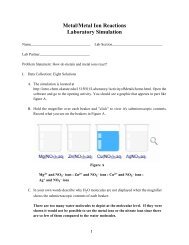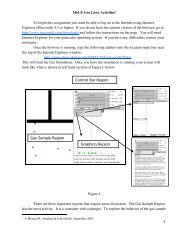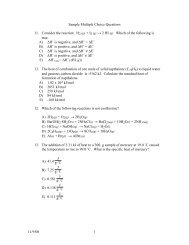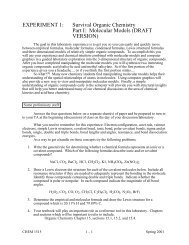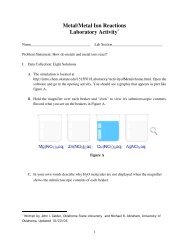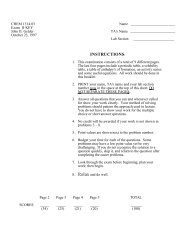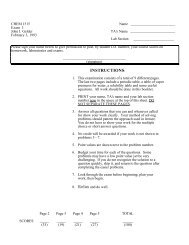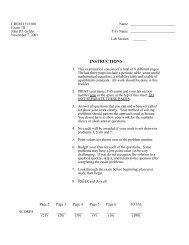Exam #2 F93
Exam #2 F93
Exam #2 F93
Create successful ePaper yourself
Turn your PDF publications into a flip-book with our unique Google optimized e-Paper software.
CHEM 1515<br />
<strong>Exam</strong> II<br />
John II. Gelder<br />
October 14, 1993<br />
Name ________________________<br />
TA's Name ________________________<br />
Lab Section ______________________<br />
INSTRUCTIONS:<br />
1. This examination consists of a total of 8 different pages.<br />
The last two pages include a periodic table, a solubility<br />
table and some useful equations. All work should be done<br />
in this booklet.<br />
2. PRINT your name, TA's name and your lab section<br />
number now in the space at the top of this sheet. DO<br />
NOT SEPARATE THESE PAGES.<br />
3. Answer all questions that you can and whenever called<br />
for show your work clearly. Your method of solving<br />
problems should pattern the approach used in lecture.<br />
You do not have to show your work for the multiple<br />
choice or short answer questions.<br />
4. No credit will be awarded if your work is not shown in<br />
problems 2 – 5.<br />
5. Point values are shown next to the problem number.<br />
6. Budget your time for each of the questions. Some<br />
problems may have a low point value yet be very<br />
challenging. If you do not recognize the solution to a<br />
question quickly, skip it, and return to the question after<br />
completing the easier problems.<br />
7. Look through the exam before beginning; plan your<br />
work; then begin.<br />
8. Relax and do well.<br />
Page 2 Page 3 Page 4 Page 5 Page 6 TOTAL<br />
SCORES _____ _____ _____ _____ _____ ______<br />
(33) (20) (23) (12) (12) (100)
CHEM 1515 <strong>Exam</strong> II PAGE 2<br />
(12) 1. Write the chemical formula(s) of the product(s) and balance the following reactions. Identify the phase<br />
of each product as either (g)as, (l)iquid, (s)olid or (aq)ueous. Soluble ionic compounds should be<br />
written in the form of their component ions.<br />
a) MgO(s) + CO 2 (g) →<br />
b) Al(s) + Fe 2 O 3 (s) →<br />
c) Na 2 CO 3 (aq) + Ca(NO 3 ) 2 (aq) →<br />
(21) 2. The rate constant for the second order decomposition of NOBr<br />
is 0.80 M –1·s –1 at 10 ˚C.<br />
2NOBr(g) → 2NO(g) + Br 2 (g)<br />
a) If the concentration of NOBr is initially 0.0289 M, calculate the concentration of NOBr after 75.0<br />
seconds.<br />
b) Calculate the half-life for this reaction under the same set of conditions as described in part a).<br />
c) How long would it take for 90.0% of the NOBr to react Assume the same initial conditions as<br />
described in part a).
CHEM 1515 <strong>Exam</strong> II PAGE 3<br />
(20) 3. The half-life for the first order decomposition of N 2 O<br />
2N 2 O(g) → 2N 2 (g) + O 2 (g)<br />
is 3.58 x 10 3 min at 730 ˚C. A sample of N 2 O is placed in a flask at this temperature and sealed.<br />
a) What will be the pressure of N 2 O in the flask after 5.50 x 10 2 minutes, given that the initial pressure<br />
of N 2 O is 2.30 atm<br />
b) Assuming the initial pressure of N 2 is zero, what is the pressure of N 2 after 5.50 x 10 2 minutes<br />
c) Calculate the total pressure exerted in the flask after one half-life (3.58 x 10 3 min).<br />
d) Suggest a two step mechanism which is consistent with the rate law.
CHEM 1515 <strong>Exam</strong> II PAGE 4<br />
(11) 4. At 200 ˚C, 0.500 mol of H 2 , 0.500 mol of N 2 and 0.500 mol of NH 3 are introduced into a 1.00 liter<br />
container and allowed to react according to the equation,<br />
At equilibrium the concentration of NH 3 is 0.384 M. Calculate K c for the reaction.<br />
(12) 5. The magnitude of the equilibrium constant for the reaction,<br />
is 54.7 at 700 K. If the initial concentrations of H 2 and I 2 are 0.0714 M and the initial concentration<br />
of HI is 0.800 M at 700 K, calculate the concentrations of all species when the reaction reaches<br />
equilibrium.
CHEM 1515 <strong>Exam</strong> II PAGE 5<br />
Short Answer:<br />
(12) 6. Consider the reaction<br />
for which ∆H rxn = –233 kJ. Assume a 1.00 L vessel containing an equilibrium mixture, predict how the<br />
[CH 4 ] will change when the equilibrium is disturbed by,<br />
a) addition of H 2<br />
b) removal of CS 2<br />
c) increase in temperature<br />
d) decrease in the volume of the reaction container
CHEM 1515 <strong>Exam</strong> II PAGE 6<br />
Multiple Choice:<br />
Print the letter (A, B, C, D, E) which corresponds to the answer selected.<br />
7. ________ 8. ________ 9. ________ 10. ________<br />
ONLY THE ANSWERS IN THE AREA ABOVE WILL BE GRADED. Select the most correct answer<br />
for each question. Each question is worth 3 points.<br />
7. How does a catalyst increase the rate of a reaction<br />
A) by changing the mechanism of the reaction.<br />
B) by increasing the activation energy of the reaction.<br />
C) by increasing the concentration of one of the reactants.<br />
D) by decreasing the difference in relative energy of the reactants and the products.<br />
8. The activation energy for a given reaction is 83.1 kJ . By what factor will the rate constant<br />
mol<br />
increase for a 10.0 ˚ temperature change when the initial temperature is 50.0 ˚C<br />
A) 0.395<br />
B) 0.929<br />
C) 2.53<br />
D) 10<br />
9. The bromination of acetone is acid-catalyzed as shown in the equation below:<br />
CH 3 COCH 3 (aq) + Br 2 (aq) H+ → products<br />
The following initial rate data was obtained for the several experiments;<br />
Exp. # [CH 3 COCH 3 ] [Br 2 ] [H + ] initial rate ⎛<br />
M<br />
⎞<br />
⎝ s ⎠<br />
1 0.30 M 0.050 M 0.050 M 5.7 x 10 –5<br />
2 0.30 M 0.100 M 0.050 M 5.7 x 10 –5<br />
3 0.30 M 0.050 M 0.100 M 1.2 x 10 –4<br />
4 0.40 M 0.050 M 0.200 M 3.1 x 10 –4<br />
The experimental rate is;<br />
A) rate = k[CH 3 COCH 3 ] 1 [Br 2 ] 1 [H + ] 1<br />
B) rate = k[CH 3 COCH 3 ] 1 [Br 2 ] 0 [H + ] 1<br />
C) rate = k[CH 3 COCH 3 ] 0 [Br 2 ] 1 [H + ] 1<br />
D) rate = k[CH 3 COCH 3 ] 1 [Br 2 ] 1 [H + ] 0<br />
10. What conditions of temperature and pressure favor the formation of products in the reaction,<br />
A) high temperature and low pressure.<br />
B) high temperature and high pressure<br />
C) low temperature and low pressure<br />
D) low temperature and high pressure
CHEM 1515 <strong>Exam</strong> II PAGE 7<br />
1<br />
2<br />
3<br />
4<br />
5<br />
6<br />
7<br />
IA<br />
1<br />
H<br />
1.008<br />
3<br />
6.94<br />
11<br />
IIA<br />
4<br />
Li Be<br />
9.01<br />
12<br />
Na Mg<br />
22.99 24.30<br />
19 20<br />
K<br />
Ca<br />
39.10 40.08<br />
37<br />
Rb Sr<br />
38<br />
85.47 87.62<br />
55 56<br />
Cs<br />
Ba<br />
132.9 137.3<br />
87 88<br />
Fr<br />
(223)<br />
Ra<br />
226.0<br />
IIIA IVA VA VIA VIIA 4.00<br />
5 6 7 8<br />
B C N O F<br />
9 10<br />
Ne<br />
10.81 12.01 14.01 16.00 19.00 20.18<br />
13 14 15 16 17 18<br />
IIIB IVB VB VIB VIIB VIII IB IIB 26.98 28.09 30.97 32.06 35.45 39.95<br />
21 22 23 24 25 26 27 28 29<br />
Sc Ti V Cr Mn Fe Co Ni Cu 30 31 32 33 34 35 36<br />
Zn Ga Ge As Se Br Kr<br />
44.96 47.88 50.94 52.00 54.94 55.85 58.93 58.69 63.55 65.38 69.72 72.59 74.92 78.96 79.90 83.80<br />
39<br />
Y Zr<br />
40 41 42 43 44 45 46 47<br />
Nb Mo Tc Ru Rh Pd A g 48 49 50 51 52 53 54<br />
Cd In Sn Sb Te I Xe<br />
88.91 91.22 92.91 95.94 (98) 101.1 102.9 106.4 107.9 112.4 114.8 118.7 121.8 127.6 126.9 131.3<br />
57 72 73 74 76 77 78 79 81 82 83 84 85 86<br />
La<br />
Periodic Table of the Elements<br />
Hf<br />
Al<br />
Si<br />
P<br />
S<br />
Cl<br />
VIIIA<br />
2<br />
Ta W Re 75<br />
Os Ir Pt Au Hg 80<br />
Tl Pb Bi Po At Rn<br />
138.9 178.5 180.9 183.8 186.2 190.2 192.2 195.1 197.0 200.6 204.4 207.2 209.0 (209) (210)<br />
89<br />
Ac 104 105 106<br />
227.0 (261) (262) (263)<br />
He<br />
Ar<br />
(222)<br />
Lanthanides<br />
Actinides<br />
58 59 60 61 62 63 64<br />
Ce Pr Nd Pm Sm Eu Gd 65 66 67 68 69 70 71<br />
Tb Dy Ho Er Tm Yb Lu<br />
140.1 140.9 144.2 (145) 150.4 152.0 157.2 158.9 162.5 164.9 167.3 168.9 173.0 175.0<br />
90 91 92 93 94 95 96<br />
Th Pa U Np Pu AmCm 97 98 99 100 101 102 103<br />
Bk Cf Es Fm Md No Lr<br />
232.0 231.0 238.0 237.0 (244) (243) (247) (247) (251) (252) (257) (258) (259) (260)<br />
Useful Information<br />
PV = nRT<br />
R = 0.0821 L·atm<br />
mol·K<br />
ln⎛<br />
k 1 ⎞<br />
⎝ k<br />
= E a<br />
2 ⎠ R ⎝ ⎛ 1<br />
T<br />
– 1 ⎠ ⎞<br />
J<br />
R = 8.314<br />
2 T 1 K·mol<br />
ln⎛<br />
[A] t ⎞<br />
1 1<br />
⎝ [A]<br />
= –kt o ⎠<br />
[A]<br />
– t [A]<br />
= kt o<br />
K p = K c (RT) ∆n<br />
x 1,2 = –b±√⎺⎺⎺⎺⎺⎺ b 2 – 4ac<br />
2a<br />
for ax 2 + bx + c = 0<br />
ln⎛<br />
K 1 ⎞<br />
⎝ K 2 ⎠<br />
= ∆H rxn<br />
R ⎝ ⎛ 1<br />
T<br />
– 1 ⎠ ⎞<br />
2 T 1
CHEM 1515 <strong>Exam</strong> II PAGE 8<br />
Solubility Table<br />
Ion Solubility Exceptions<br />
NO – 3 soluble none<br />
ClO – 4 soluble none<br />
Cl – soluble except Ag + , Hg 2+ 2 , *Pb 2+<br />
I – soluble except Ag + , Hg 2+ 2 , Pb 2+<br />
SO 2– 4 soluble except Ca 2+ , Ba 2+ , Sr 2+ , Hg 2+ , Pb 2+ , Ag +<br />
CO 2– 3 insoluble<br />
+<br />
except Group IA and NH 4<br />
PO 3–<br />
+<br />
4 insoluble except Group IA and NH 4<br />
- OH insoluble except Group IA, *Ca 2+ , Ba 2+ , Sr 2+<br />
S 2– insoluble except Group IA, IIA and NH + 4<br />
Na + soluble none<br />
NH + 4 soluble none<br />
K + soluble none<br />
*slightly soluble




